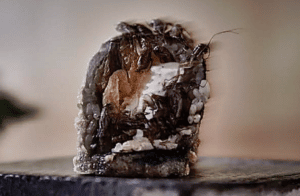I never thought I would see anything like this. I’ve seen spam sushi rainbow sushi, even sushi donuts, but nothing like this! Miya Sushi might just be way ahead of their time. Their crazy menu pushes the boundaries, and even the most adventurous restaurateurs may meet their match! The restaurant is created with an incredible message at its heart. Miya Sushi’s vision of the future is of a world where by 2150 we will find a sustainable balance with nature. That means eating less animals, humane farming practices, and a celebration of the planet we live on. It also means a focus on foods that have the smallest impact on their environments, and fighting invasive species by eating them!
This cricket sushi roll pushes culinary boundaries
Even the most adventurous eater is going to be shocked by some of the dishes. The Crickleberry Brie sushi is chock filled with protein – from an outlandish source. Crickets!

Images are property of Miya Sushi 🙂
When you compare the ecological impact of farming cows or other large livestock, the difference is outstanding. Bugs offer a highly economical protein alternative. High in nutritional value and filled to the brim with protein, some say that bug farming is going to be a major industry in the future. Bug farms take much less space than conventional farms.
Would you be willing to try the Crickleberry sushi? Or is it simply too far out to even taste? I’m not sure if I would like it, but I would be willing to try! I mean, really, is it so different to eat escargot? Why are some bugs considered delicious and others disgusting? Having an open mind when it comes to food is important. But even an open minded eater might have trouble with cricket sushi!
Sushi made from invasive species
Some sushi restaurants serve seafood that have sustainability concerns. Miya Sushi does the opposite. Head Chef Bun Lai is an expert in turning invasive species into delicious dishes. What do you do when you are faced with invasive species? You eat them!

Miya Sushi has an entire section of the menu dedicated to Invasive Species. Mugwort, knotweed, and various other weeds are all invasive plants that chef Bun Lai has managed to turn into incredible creations. And that’s not all. In addition to plants, chef Bun Lai uses invasive seafood expertly. Sashimi options include nine-spice invasive asian carp sashimi and kiribati sashimi, which uses lionfish. The image above is of the carp sashimi. It is prepared using traditional methods, frozen in the same way that Inuit people continue to freeze carp based on their traditional methods. This chef can take any invasive species and make a dish out of it. Catfish is another invasive seafood which he pairs with asparagus, apricots, and black beans to create a truly wild dish.
Miya Sushi deconstructs the food chain
Currently, a third of wild caught fish is turned into fish feed for carnivorous fish. The concept of Miya Sushi is to go right to the bottom of the food chain and work upwards to find seafood that is both sustainable and has a low impact on the environment. This means specializing in herbivores such as catfish, tilapia, and carp.
When you eat fish at Miya Sushi, you can be sure you are making an ethical choice. Every ingredient in their cooking has been meticulously studied to see its effect in the broader environment. An example are their shrimp and prawn offerings. Instead of using wild caught tropical shrimp that have an extreme bycatch ratio, they use Florida shrimp and Alaskan spot prawns that have little to no impact in terms of bycatch.
Miya Sushi’s concepts haven’t hit the mainstream yet
While many consumers are becoming more concerned with sustainability and the ethics of the foods that they eat, the concepts of Miya Sushi have yet to become truly mainstream. While the head chef of Miya Sushi has specialized in turning invasive species into delicious dinners, most chefs are trained in more traditional recipes. It takes a huge amount of willpower and courage to create a restaurant as wild and unique as Miya Sushi. We wish them all the best in continuing to serve up tasty and sustainable dishes! If you are interested in sustainable sushi, you may be interested in reading our guide to eating sustainable sushi. It doesn’t get much more sustainable than invasive species sushi!
I have always been fascinated by the creation and culture of different foods, particularly sushi and sashimi in the modern era of Japanese cuisine. I am a classically trained chef and sushi connoisseur, also having operated a food service company and enjoy investigating and experimenting with food around the world.
